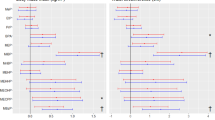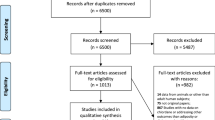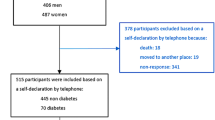Abstract
We investigated cross-sectional associations of body composition and weight change with polychlorinated biphenyls (PCB) and organochlorine pesticides/pesticide metabolites measured in blood collected at the baseline of the Physical Activity for Total Health study of postmenopausal, overweight women living in the Seattle, Washington metropolitan area. Indicators of greater adiposity were associated with lower plasma concentrations of most PCBs with six or more chlorine atoms. This pattern was observed for current weight, body mass index, fat mass percent, subcutaneous abdominal fat, intra-abdominal fat, waist circumference, hip circumference, waist-to-hip ratio, and maximum adult weight. Conversely, PCB 105, PCB 118, and p,p′-DDE were generally increased or showed no association with these variables. Weight gain since age 35 was associated with lower concentrations of almost every organochlorine we studied, and past weight loss episodes of at least 20 pounds (≥9.1 kg) were associated with higher concentrations. Our results have implications for epidemiologic studies of organochlorines in terms of covariates that may be important to consider in statistical analyses, particularly as such considerations may differ importantly by specific analyte. Our finding of increased organochlorine concentrations with past weight loss episodes may have public health significance; however, this association requires confirmation in longitudinal studies.
This is a preview of subscription content, access via your institution
Access options
Subscribe to this journal
Receive 6 print issues and online access
$259.00 per year
only $43.17 per issue
Buy this article
- Purchase on Springer Link
- Instant access to full article PDF
Prices may be subject to local taxes which are calculated during checkout



Similar content being viewed by others
References
Falk C., Hanrahan L., Anderson H.A., Kanarek M.S., Draheim L., and Needham L., et al. Body burden levels of dioxin, furans, and PCBs among frequent consumers of Great Lakes sport fish. The Great Lakes Consortium. Environ Res 1999: 80 (2 Pt 2): S19–S25.
Kang D., Tepper A., and Patterson D.G. Jr. Coplanar PCBs and the relative contribution of coplanar PCBs, PCDDs, and PCDFs to the total 2,3,7,8-TCDD toxicity equivalents in human serum. Chemosphere 1997: 35: 503–511.
Pelletier C., Despres J.P., and Tremblay A. Plasma organochlorine concentrations in endurance athletes and obese individuals. Med Sci Sports Exerc 2002: 34: 1971–1975.
Sandanger T.M., Sinotte M., Dumas P., Marchand M., Sandau C.D., and Pereg D., et al. Plasma concentrations of selected organobromine compounds and polychlorinated biphenyls in postmenopausal women of Quebec, Canada. Environ Health Perspect 2007: 115: 1429–1434.
Agudo A., Goni F., Etxeandia A., Vives A., Millan E., and Lopez R., et al. Polychlorinated biphenyls in Spanish adults: determinants of serum concentrations. Environ Res 2009: 109: 620–628.
Wolff M.S., Anderson H.A., Britton J.A., and Rothman N. Pharmacokinetic variability and modern epidemiology—the example of dichlorodiphenyltrichloroethane, body mass index, and birth cohort. Cancer Epidemiol Biomarkers Prev 2007: 16: 1925–1930.
Chevrier J., Dewailly E., Ayotte P., Mauriege P., Despres J.P., and Tremblay A. Body weight loss increases plasma and adipose tissue concentrations of potentially toxic pollutants in obese individuals. Int J Obes Relat Metab Disord 2000: 24: 1272–1278.
Pelletier C., Doucet E., Imbeault P., and Tremblay A. Associations between weight loss-induced changes in plasma organochlorine concentrations, serum T(3) concentration, and resting metabolic rate. Toxicol Sci 2002b: 67: 46–51.
Walford R.L., Mock D., MacCallum T., and Laseter J.L. Physiologic changes in humans subjected to severe, selective calorie restriction for two years in biosphere 2: health, aging, and toxicological perspectives. Toxicol Sci 1999: 52 (2 Suppl): 61–65.
McTiernan A., Ulrich C.M., Yancey D., Slate S., Nakamura H., and Oestreicher N., et al. The Physical Activity for Total Health (PATH) Study: rationale and design. Med Sci Sports Exerc 1999: 31: 1307–1312.
Shade E.D., Ulrich C.M., Wener M.H., Wood B., Yasui Y., and LaCroix K., et al. Frequent intentional weight loss is associated with lower natural killer cell cytotoxicity in postmenopausal women: possible long-term immune effects. J Am Diet Assoc 2004: 104: 903–912.
Patterson R.E., Kristal A.R., Tinker L.F., Carter R.A., Bolton M.P., and Agurs-Collins T. Measurement characteristics of the Women's Health Initiative food frequency questionnaire. Ann Epidemiol 1999: 9: 178–187.
Ballschmiter K., and Zell M. Baseline studies of the global pollution. I. Occurrence of organohalogens in pristine European and antarctic aquatic environments. Int J Environ Anal Chem 1980: 8: 15–35.
Turner W., DiPietro E., Cash T.P., McClure P.C., Patterson D.G Jr., and Shirkhan H. An improved SPE extraction and automated sample cleanup method for serum PCDDs, PCDFs, and coplanar PCBs. Organohalogen Compounds 1994: 19: 31–35.
Mohanka M., Irwin M., Heckbert S.R., Yasui Y., Sorensen B., and Chubak J., et al. Serum lipoproteins in overweight/obese postmenopausal women: a one-year exercise trial. Med Sci Sports Exerc 2006: 38: 231–239.
Patterson D.G. Jr., Wong L.Y., Turner W.E., Caudill S.P., Dipietro E.S., and McClure P.C., et al. Levels in the US population of those persistent organic pollutants (2003–2004) included in the Stockholm Convention or in other long range transboundary air pollution agreements. Environ Sci Technol 2009: 43: 1211–1218.
Cerna M., Maly M., Grabic R., Batariova A., Smid J., and Benes B. Serum concentrations of indicator PCB congeners in the Czech adult population. Chemosphere 2008: 72: 1124–1131.
Dirinck E., Jorens P.G., Covaci A., Geens T., Roosens L., Neels H., Mertens I., and Van Gaal L . Obesity and persistent organic pollutants: possible obesogenic effect of organochlorine pesticides and polychlorinated biphenyls. Obesity (Silver Spring) 2011: 19: 709–714.
Hue O., Marcotte J., Berrigan F., Simoneau M., Dore J., and Marceau P., et al. Plasma concentration of organochlorine compounds is associated with age and not obesity. Chemosphere 2007: 67: 1463–1467.
Hagmar L. Polychlorinated biphenyls and thyroid status in humans: a review. Thyroid 2003: 13: 1021–1028.
Hagmar L., Wallin E., Vessby B., Jonsson B.A., Bergman A., and Rylander L. Intra-individual variations and time trends 1991–2001 in human serum levels of PCB, DDE and hexachlorobenzene. Chemosphere 2006: 64: 1507–1513.
Vo T.T., Gladen B.C., Cooper G.S., Baird D.D., Daniels J.L., and Gammon M.D., et al. Dichlorodiphenyldichloroethane and polychlorinated biphenyls: intraindividual changes, correlations, and predictors in healthy women from the southeastern United States. Cancer Epidemiol Biomarkers Prev 2008: 17: 2729–2736.
Wolff M.S., Britton J.A., Teitelbaum S.L., Eng S., Deych E., and Ireland K., et al. Improving organochlorine biomarker models for cancer research. Cancer Epidemiol Biomarkers Prev 2005: 14: 2224–2236.
Jantschi L., and Bolboaca S. Molecular descriptors family on structure activity relationships 6. Octanol-water partition coefficient of polychlorinated biphenyls. Leonardo Electronic J Pr Technol 2006: 8: 71–86.
Bignert A., Olsson M., Persson W., Jensen S., Zakrisson S., and Litzen K., et al. Temporal trends of organochlorines in Northern Europe, 1967–1995. Relation to global fractionation, leakage from sediments and international measures. Environ Pollut 1998: 99: 177–198.
Loganathan B.G., Tanabe S., Hidaka Y., Kawano M., Hidaka H., and Tatsukawa R. Temporal trends of persistent organochlorine residues in human adipose tissue from Japan, 1928–1985. Environ Pollut 1993: 81: 31–39.
Tremblay A., and Chaput J.P. About unsuspected potential determinants of obesity. Appl Physiol Nutr Metab 2008: 33: 791–796.
Mullerova D., Kopecky J., Matejkova D., Muller L., Rosmus J., and Racek J., et al. Negative association between plasma levels of adiponectin and polychlorinated biphenyl 153 in obese women under non-energy-restrictive regime. Int J Obes (Lond) 2008: 32: 1875–1878.
Mendez M.A., Garcia-Esteban R., Guxens M., Vrijheid M., Kogevinas M., and Goni F., et al. Prenatal organochlorine compound exposure, rapid weight gain and overweight in infancy. Environ Health Perspect 2011: 119: 272–278.
Anderson J.W., and Konz E.C. Obesity and disease management: effects of weight loss on comorbid conditions. Obes Res 2001: 9 (Suppl 4): 326S–334S.
Fujimoto W.Y., Jablonski K.A., Bray G.A., Kriska A., Barrett-Connor E., and Haffner S., et al. Body size and shape changes and the risk of diabetes in the diabetes prevention program. Diabetes 2007: 56: 1680–1685.
Torgerson J.S., and Sjostrom L. The Swedish Obese Subjects (SOS) study—rationale and results. Int J Obes Relat Metab Disord 2001: 25 (Suppl 1): S2–S4.
Serdula M.K., Mokdad A.H., Williamson D.F., Galuska D.A., Mendlein J.M., and Heath G.W. Prevalence of attempting weight loss and strategies for controlling weight. JAMA 1999: 282: 1353–1358.
Kovalchik S. Validity of adult lifetime self-reported body weight. Public Health Nutr 2009: 12: 1072–1077.
De Roos A.J., Hartge P., Lubin J.H., Colt J.S., Davis S., and Cerhan J.R., et al. Persistent organochlorine chemicals in plasma and risk of non-Hodgkin's lymphoma. Cancer Res 2005: 65: 11214–11226.
Engel L.S., Laden F., Andersen A., Strickland P.T., Blair A., and Needham L.L., et al. Polychlorinated biphenyl levels in peripheral blood and non-Hodgkin's lymphoma: a report from three cohorts. Cancer Res 2007: 67: 5545–5552.
Rothman N., Cantor K.P., Blair A., Bush D., Brock J.W., and Helzlsouer K., et al. A nested case-control study of non-Hodgkin lymphoma and serum organochlorine residues. Lancet 1997: 350: 240–244.
Spinelli J.J., Ng C.H., Weber J.P., Connors J.M., Gascoyne R.D., and Lai A.S., et al. Organochlorines and risk of non-Hodgkin lymphoma. Int J Cancer 2007: 121: 2767–2775.
Everett C.J., Frithsen I.L., Diaz V.A., Koopman R.J., Simpson W.M. Jr., and Mainous A.G. III. Association of a polychlorinated dibenzo-p-dioxin, a polychlorinated biphenyl, and DDT with diabetes in the 1999–2002 National Health and Nutrition Examination Survey. Environ Res 2007: 103: 413–418.
Fierens S., Mairesse H., Heilier J.F., De Burbure C., Focant J.F., and Eppe G., et al. Dioxin/polychlorinated biphenyl body burden, diabetes and endometriosis: findings in a population-based study in Belgium. Biomarkers 2003: 8: 529–534.
Vasiliu O., Cameron L., Gardiner J., Deguire P., and Karmaus W. Polybrominated biphenyls, polychlorinated biphenyls, body weight, and incidence of adult-onset diabetes mellitus. Epidemiology 2006: 17: 352–359.
De Roos A.J., Ulrich C.M., Ray R.M., Mossavar-Rahmani Y., Rosenberg C.A., and Caan B.J., et al. Intentional weight loss and risk of lymphohematopoietic cancers. Cancer Causes Control 2010: 21: 223–236.
Acknowledgements
This research was funded by a grant from the National Institute of Environmental Health Sciences of the National Institutes of Health (R03ES015787).
Author information
Authors and Affiliations
Corresponding author
Ethics declarations
Competing interests
The authors declare no conflict of interest.
Additional information
Supplementary Information accompanies the paper on the Journal of Exposure Science and Environmental Epidemiology website
Supplementary information
Rights and permissions
About this article
Cite this article
De Roos, A., Ulrich, C., Sjodin, A. et al. Adiposity, body composition, and weight change in relation to organochlorine pollutant plasma concentrations. J Expo Sci Environ Epidemiol 22, 617–624 (2012). https://doi.org/10.1038/jes.2012.43
Received:
Accepted:
Published:
Issue Date:
DOI: https://doi.org/10.1038/jes.2012.43
Keywords
This article is cited by
-
Lipogenic Potency of Individual Perfluorinated Alkyl Acids (PFAAs) and Persistent Organic Pollutant (POP) Mixtures at Human Blood-Based Exposure Levels on Adipogenesis in 3T3-L1 Cells
Exposure and Health (2022)
-
Inverse correlation among organochlorine pesticide levels to total lipid serum contents: a preliminary study in Veracruz, México
Environmental Monitoring and Assessment (2015)



